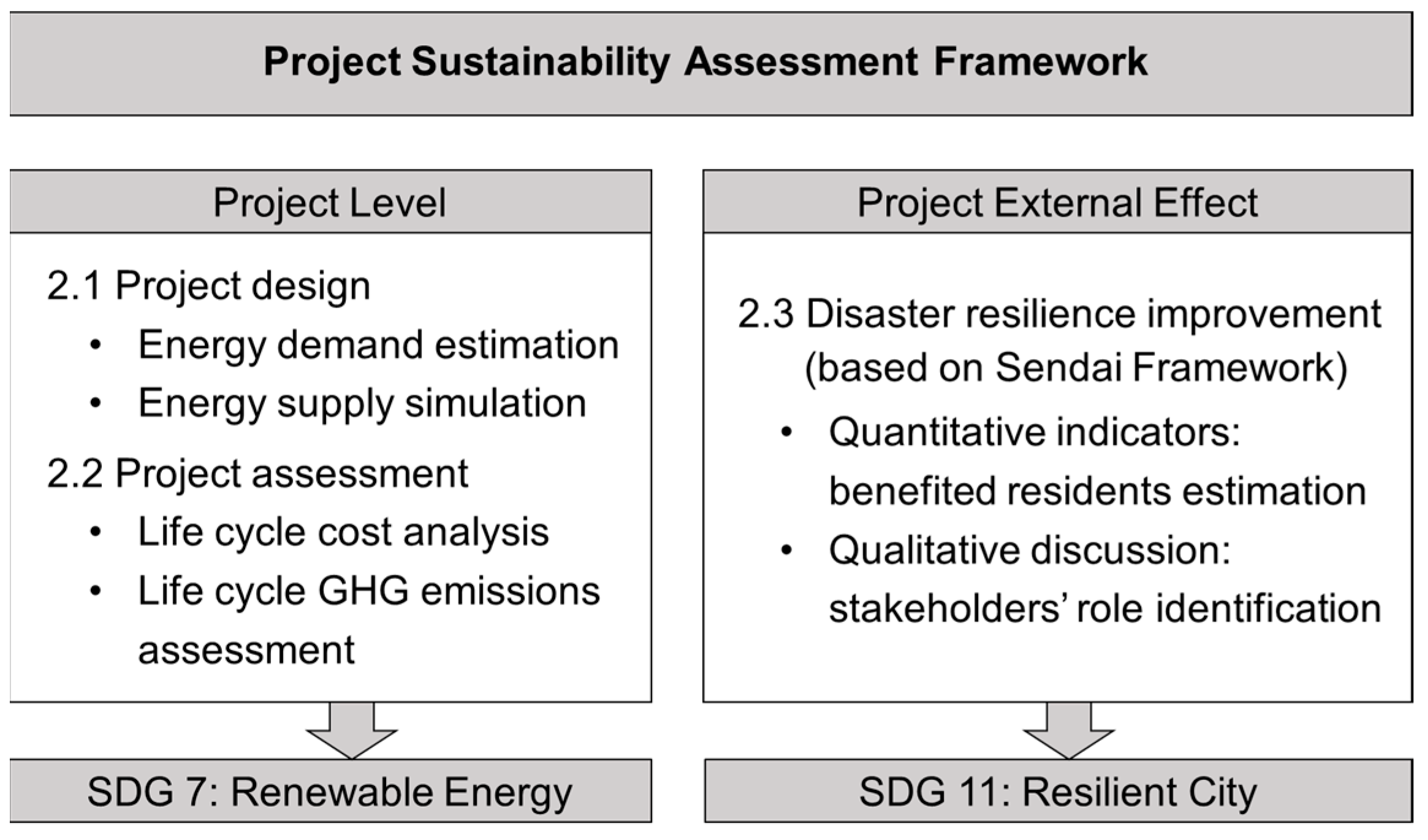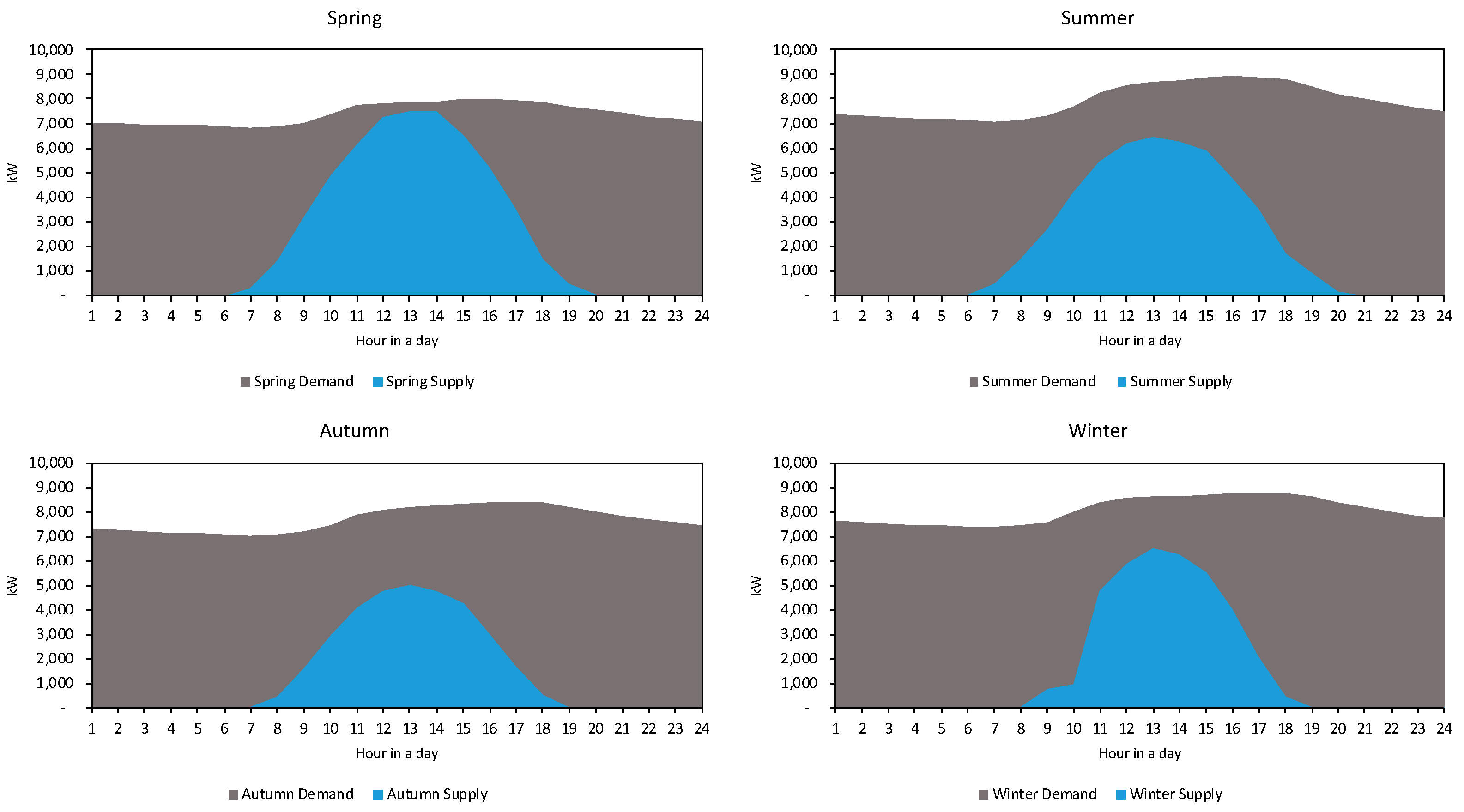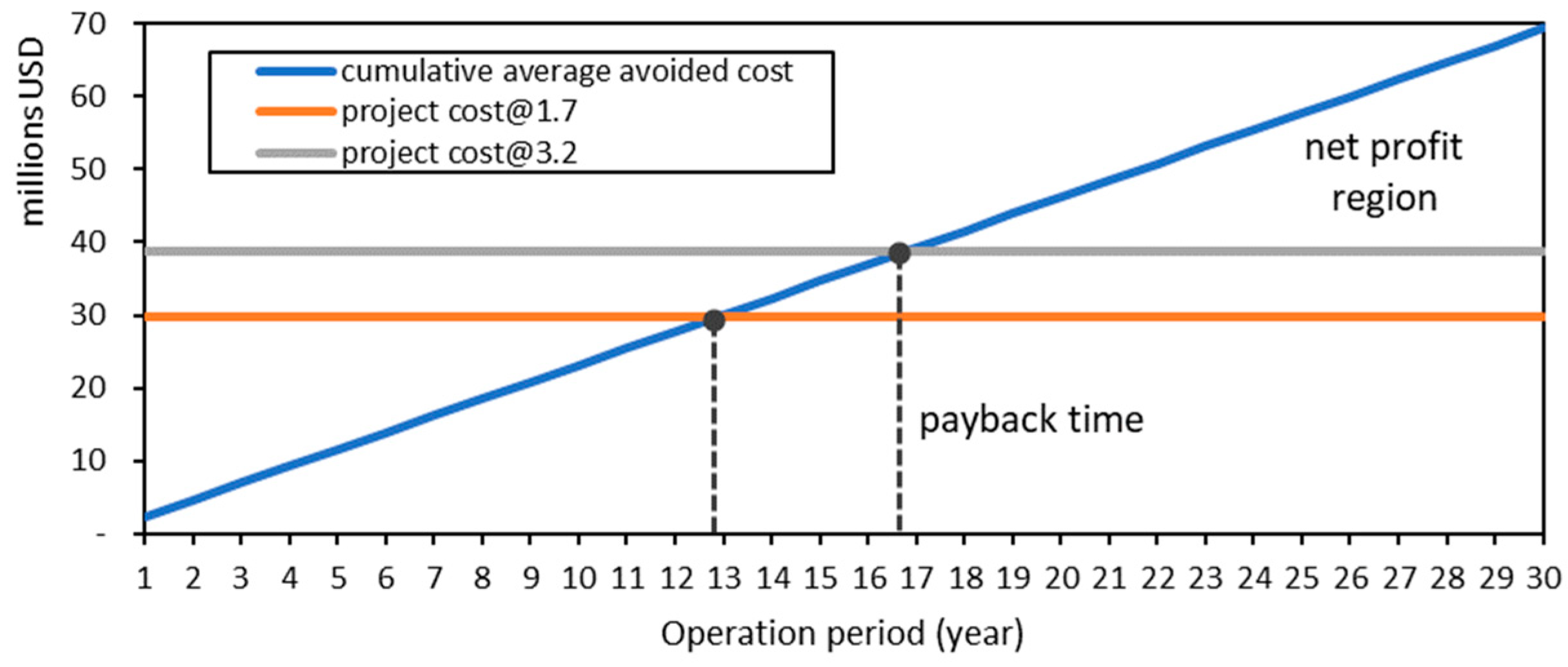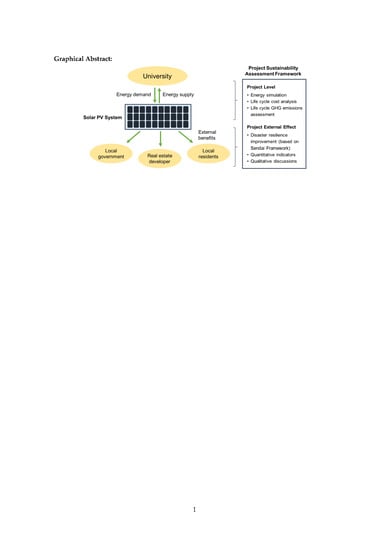Incorporating External Effects into Project Sustainability Assessments: The Case of a Green Campus Initiative Based on a Solar PV System
Abstract
1. Introduction
2. Materials and Methods
- The Kashiwa Campus is one of the new campuses of the University of Tokyo. It was established around 2000 and consists of ten graduate schools and research institutes. Apart from classroom usage, intensive electricity consumption was observed in laboratory activities, including the operation of super computers. A goal to cut the campus CO2 emissions by 50% at 2030 relative to the level of 2012 was set in an action plan, known as the Todai Sustainable Campus Project [8].
- The neighborhood of Kashiwa Campus is composed of industrial sites, a recreational park, and a residential area (see Supplementary Materials: Figure S1) [9]. In addition, Kashiwanoha Smart City is located approximately 2 km from the campus. The smart city has an area of 127,000 m2 and has a plan to expand to 3 million m2 by 2030 [10]. This ambitious project is led by a domestically reputed real estate developer, Mitsui Fudosan; the University of Tokyo is involved as an academic partner in different stages of the development plan.
2.1. Design of the On-Campus Solar Photovoltaic System
2.2. Assessment of the Solar Photovoltaic System
2.2.1. Life Cycle Cost Analysis
2.2.2. Life Cycle GHG Emissions Assessment
2.3. Assessment of External Effect: Disaster Resilience Improvement
2.3.1. Indicators for Disaster Resilience and Preparedness
2.3.2. Anticipated Roles for Stakeholders
3. Results
3.1. Capacity of the On-Campus Solar Photovoltaic System
3.2. Project Level Assessment
3.2.1. Life Cycle Cost
3.2.2. Life Cycle GHG Emissions
3.3. External Effect on Local Community
4. Discussion
4.1. Design of the Renewable Energy System
4.2. Sustainability Performance of the Project
- As mentioned in Section 4.1., the current design did not include an energy storage system, thus it completely relies on the grid system to adjust the intermittency of solar power. An additional battery storage system would impact the performance greatly.
- Publicly available information on the cost of renewable energy systems is very limited. The data for this study was primarily acquired from a third party, the International Renewable Energy Agency [9], which may slightly differ from local conditions.
- The assumption of the avoided electricity rate, 0.16 USD/kWh, based on a utility-scale higher daytime rate was sensitive to the payback time and net savings estimation. This rate might be subject to change in the future.
- The monetary value of the net savings did not necessarily mean a positive income for the university, as the power was intended for on-campus consumption. Meanwhile, there was no feed-in tariff policy in place at present, particularly for utility-scale solar power generation.
Supplementary Materials
Author Contributions
Funding
Acknowledgments
Conflicts of Interest
Abbreviations
| GHG | Greenhouse gas |
| GWP | Global Warming Potential |
| IPCC | Intergovernmental Panel on Climate Change |
| ISO | International Organization for Standardization |
| LCA | Life cycle assessment |
| LCC | Life cycle cost analysis |
| LCOE | Levelized cost of electricity |
| PV | Photovoltaic |
| SDG | Sustainable Development Goal |
References
- Alshuwaikhat, H.M.; Abubakar, I. An integrated approach to achieving campus sustainability: Assessment of the current campus environmental management practices. J. Clean Prod. 2008, 16, 1777–1785. [Google Scholar] [CrossRef]
- Tan, H.; Chen, S.; Shi, Q.; Wang, L. Development of green campus in China. J. Clean Prod. 2014, 64, 646–653. [Google Scholar] [CrossRef]
- Finkbeiner, M.; Schau, E.M.; Lehmann, A.; Traverso, M. Towards life cycle sustainability assessment. Sustainability 2010, 2, 3309–3322. [Google Scholar] [CrossRef]
- Finkbeiner, M.; Inaba, A.; Tan, R.; Christiansen, K.; Klüppel, H.J. The new international standards for life cycle assessment: ISO 14040 and ISO 14044. Int. J. Life Cycle Assess. 2006, 11, 80–85. [Google Scholar] [CrossRef]
- Matthews, H.S.; Hendrickson, C.T.; Matthews, D.H. Life Cycle Assessment: Quantitative Approaches for Decisions that Matter. 2015. Available online: https://www.lcatextbook.com/ (accessed on 20 September 2019).
- Takahashi, H. The Lessons of the Great Tohoku Earthquake and Its Effects on Japan’s Economy’. Fujitsu Research Institute. 2012. Available online: https://www.fujitsu.com/jp/group/fri/en/column/message/2012/2012-01-10.html (accessed on 20 September 2019).
- Fukushima, Y.; Kikuchi, Y.; Kajikawa, Y.; Kubota, M.; Nakagaki, T.; Matsukata, M.; Kato, Y.; Koyama, M. Tackling power outages in Japan: The earthquake compels a swift transformation of the power supply. J. Chem. Eng. Jpn. 2011, 44, 365–369. [Google Scholar] [CrossRef][Green Version]
- Todai Sustainable Campus Project (TSCP). Available online: http://www.tscp.u-tokyo.ac.jp/en (accessed on 28 August 2019).
- Kashiwa City Planning Map. Available online: http://www.machi-info.jp/machikado/kashiwa_city2/index.jsp (accessed on 20 September 2019). (In Japanese).
- Kashiwanoha Smart City. Available online: https://www.kashiwanoha-smartcity.com/en (accessed on 28 August 2019).
- Battke, B.; Schmidt, T.S.; Grosspietsch, D.; Hoffmann, V.H. A review and probabilistic model of lifecycle costs of stationary batteries in multiple applications. Renew. Sustain. Energy Rev. 2013, 25, 240–250. [Google Scholar] [CrossRef]
- United Nations. Sustainable Development Goals Knowledge Platform. Available online: https://sustainabledevelopment.un.org/ (accessed on 20 September 2019).
- UNISDR. Sendai Framework for Disaster Risk Reduction 2015–2030; United Nations Office for Disaster Risk Reduction (UNISDR): Geneva, Switzerland, 2015. [Google Scholar]
- Esteban, M.; Zhang, Q.; Utama, A. Estimation of the energy storage requirement of a future 100% renewable energy system in Japan. Energy Policy 2012, 47, 22–31. [Google Scholar] [CrossRef]
- Monitoring Station in Chiba. Available online: http://air.taiki.pref.chiba.lg.jp/ (accessed on 28 August 2019). (In Japanese).
- Sharp Solar Panels. Available online: http://www.sharp-world.com/solar/en/ (accessed on 28 August 2019).
- Jungbluth, N. Life cycle assessment of crystalline photovoltaics in the Swiss ecoinvent database. Prog. Photovolt. Res. Appl. 2005, 13, 429–446. [Google Scholar] [CrossRef]
- Bolinger, M.; Seel, J. Utility Scale Solar 2015; Lawrence Berkeley National Laboratory: Berkeley, CA, USA, 2016. [Google Scholar]
- International Renewable Energy Agency (IRENA). The Power to Change: Solar and Wind Cost Reduction Potential to 2025; IRENA: Abu Dhabi, UAE, 2016. [Google Scholar]
- Newnan, D.G.; Eschenbach, T.; Lavelle, J.P.; Wheeler, E. Engineering Economic Analysis, 13th ed.; Oxford University Press: New York, NY, USA, 2017. [Google Scholar]
- Briano, J.I.; Baez, M.J.; Morales, R.M. PV Grid Parity Monitor: Residential Sector 3rd Issue; CREARA: Madrid, Spain, 2015. [Google Scholar]
- Peake, S. Renewable Energy: Power for a Sustainable Future, 4th ed.; Oxford University Press: Oxford, UK, 2017. [Google Scholar]
- TEPCO Electricity Price for Contract above 500 kW. Available online: http://www.tepco.co.jp/ep/corporate/plan_h/plan03.html (accessed on 28 August 2019). (In Japanese).
- Guinée, J. Handbook on life cycle assessment—Operational guide to the ISO standards. Int. J. Life Cycle Assess. 2001, 6, 255. [Google Scholar] [CrossRef]
- Jungbluth, N.; Stucki, M.; Flury, K.; Frischknecht, R.; Büsser, S. Life Cycle Inventories of Photovoltaics; 2012 Version; ESU-services Ltd.: Uster, Switzerland, 2012; Available online: http://esu-services.ch/fileadmin/download/publicLCI/jungbluth-2012-LCI-Photovoltaics.pdf (accessed on 28 August 2019).
- Ecoinvent. Available online: https://www.ecoinvent.org/home.html (accessed on 28 August 2019).
- Myhre, G.; Shindell, D.; Bréon, F.-M.; Collins, W.; Fuglestvedt, J.; Huang, J.; Koch, D.; Lamarque, J.-F.; Lee, D.; Mendoza, B.; et al. Anthropogenic and Natural Radiative Forcing. In Climate Change 2013: The Physical Science Basis. Contribution of Working Group I to the Fifth Assessment Report of the Intergovernmental Panel on Climate Change; Stocker, T.F., Qin, D., Plattner, G.-K., Tignor, M., Allen, S.K., Boschung, J., Nauels, A., Xia, Y., Bex, V., Midgley, P.M., Eds.; Cambridge University Press: Cambridge, UK; New York, NY, USA, 2013; pp. 659–740. [Google Scholar]
- OpenLCA Software. Available online: http://www.openlca.org/ (accessed on 28 August 2019).
- Barnett, A.H.; Yandle, B. The end of the externality revolution. Soc. Philos. Policy 2009, 26, 130–150. [Google Scholar] [CrossRef]
- UN General Assembly. Report of the Open-Ended Intergovernmental Expert Working Group on Indicators and Terminology Relating to Disaster Risk Reduction (A/71/644); United Nations General Assembly: New York, NY, USA, 2016. [Google Scholar]
- Statistics of Population in Kashiwanoha. Available online: http://www.city.kashiwa.lg.jp/soshiki/020800/p009116.html (accessed on 28 August 2019). (In Japanese).
- IRENA. Renewable Power Generation Costs in 2018; International Renewable Energy Agency: Abu Dhabi, UAE, 2019. [Google Scholar]
- Kommalapati, R.; Kadiyala, A.; Shahriar, M.; Huque, Z. Review of the life cycle greenhouse gas emissions from different photovoltaic and concentrating solar power electricity generation systems. Energies 2017, 10, 350. [Google Scholar] [CrossRef]
- UNDRR. Sendai Framework Voluntary Commitments Synthesis and Analysis Report 2019; United Nations Office for Disaster Risk Reduction (UNDRR): Geneva, Switzerland, 2019. [Google Scholar]
- UNDRR Sendai Framework Voluntary Commitments (SFVC) Online Platform. Available online: https://sendaicommitments.unisdr.org/ (accessed on 28 August 2019).
- Lund, H. Renewable Energy Systems: A Smart Energy Systems Approach to the Choice and Modeling of 100% Renewable Solutions, 2nd ed.; Academic Press: Waltham, MA, USA; Oxford, UK, 2014. [Google Scholar]
- IRENA. Electricity Storage and Renewables: Costs and Markets to 2030; International Renewable Energy Agency: Abu Dhabi, UAE, 2017. [Google Scholar]



| Parameter | Symbol | Value |
|---|---|---|
| Conversion efficiency | η | 15.5% |
| Efficiency of temperature | Ftemp, sping, autumn | 85% |
| Ftemp, summer | 80% | |
| Ftemp, winter | 90% | |
| Efficiency of inverter | Finv | 95% |
| Efficiency of other factors | Fother | 95% |
| Cost Components | Amount | Unit |
|---|---|---|
| Total installed cost | 2518 | USD/kW |
| - Balance of System | 1678 | USD/kW |
| - Module | 700 | USD/kW |
| - Inverter | 140 | USD/kW |
| Operation/Maintenance | 15 | USD/kW/year |
| Global Warming Potential (kg CO2-eq) | Overall Contribution (%) | |
|---|---|---|
| Solar Panel | 24,477,674 | 69.6 |
| Mounting system | 7,010,592 | 19.9 |
| Inverter | 2,885,345 | 8.2 |
| Electric installation | 772,061 | 2.2 |
| Electricity use | 960 | 0.003 |
| Total | 35,146,632 | 100 |
| Stakeholders | Potential Contribution | Anticipated Benefits |
|---|---|---|
| The university | Provide rooftop area and open space for the solar panels; fund the project | Reduce the carbon footprint from intensive energy demand |
| Nearby residents | Willing to incur additional expenses for the emergency power supply | Access to emergency power in the event of massive power outage |
| Kashiwa City Government | Facilitate the project; provide policy support; fund the project | Improve the disaster resilience and preparedness of the region |
| Mitsui Fudosan (Developer) | Connect the project to existing smart city infrastructure; fund the project | Increase the value of developed properties by highlighting the improved energy security |
© 2019 by the authors. Licensee MDPI, Basel, Switzerland. This article is an open access article distributed under the terms and conditions of the Creative Commons Attribution (CC BY) license (http://creativecommons.org/licenses/by/4.0/).
Share and Cite
Teah, H.S.; Yang, Q.; Onuki, M.; Teah, H.Y. Incorporating External Effects into Project Sustainability Assessments: The Case of a Green Campus Initiative Based on a Solar PV System. Sustainability 2019, 11, 5786. https://doi.org/10.3390/su11205786
Teah HS, Yang Q, Onuki M, Teah HY. Incorporating External Effects into Project Sustainability Assessments: The Case of a Green Campus Initiative Based on a Solar PV System. Sustainability. 2019; 11(20):5786. https://doi.org/10.3390/su11205786
Chicago/Turabian StyleTeah, Heng Shue, Qinyu Yang, Motoharu Onuki, and Heng Yi Teah. 2019. "Incorporating External Effects into Project Sustainability Assessments: The Case of a Green Campus Initiative Based on a Solar PV System" Sustainability 11, no. 20: 5786. https://doi.org/10.3390/su11205786
APA StyleTeah, H. S., Yang, Q., Onuki, M., & Teah, H. Y. (2019). Incorporating External Effects into Project Sustainability Assessments: The Case of a Green Campus Initiative Based on a Solar PV System. Sustainability, 11(20), 5786. https://doi.org/10.3390/su11205786






